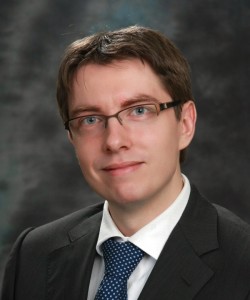Trevor Hanson
1) What is your official current position and title?
Assistant Professor, Department of Civil Engineering, University of New Brunswick.
2) What is your educational background?
I hold a BScE, MScE, and PhD in Civil Engineering from the University of New Brunswick. I am also a registered Professional Engineer with Engineers and Geoscientists New Brunswick.
3) Talk a little about your career path? Where did your passion for the research/work that you do originate and how did it develop?
My passion for transportation began as an undergraduate student in Civil Engineering and was fostered throughout my MScE degree as part of the UNB Transportation Group. My thesis involved piloting a new type of electronic travel diary to help better understand the travel habits of urban and rural older drivers at a level of detail not previously explored. I credit my supervisors (Dr. Eric Hildebrand & Prof Martin Gordon) for putting me on the research path that combines the technical and social aspects of transportation engineering. This informed my work during my three years with the NB Department of Transportation (Policy Branch), where I worked on several policy and technology initiatives. I felt a calling to an academic career path, so I returned to the UNB Transportation Group to begin a PhD with Dr. Hildebrand that built on my previous work, but going considerably deeper into understanding the travel behaviour of rural older adults. With this understanding, my goal was to help lead to solutions for those without transportation and enhance mobility and safety. Throughout this time, I also worked to help support rural community development in the Geary Area in rural NB (where I am originally from). After my PhD, I joined the UNB Department of Civil Engineering in 2011 and now teach and research in Transportation Engineering and Planning.
4) Tell us about one or two of your current projects?
I have just received an NSERC Discovery Grant valued at $23,000 per year for 5 years to develop the planning and forecasting tools for age-friendly community transportation, with a focus on volunteer driver programs. I am currently working with an undergraduate student to try and develop a common trip data collection and reporting methodology for the several rural and regional volunteer driver programs operating in New Brunswick. Many of these programs are new and as they become more successful, carrying more passengers and travelling further, there is a greater need to formalize their support processes.
5) How do you see your research/work in terms of possibly contributing to evidence-based public policy?
Enhancing how volunteer driver programs collect data will help them in managing their day-to-day and long term operations. By extension, reviewing all of the programs together will help us understand how these programs serve to meet transportation needs more broadly, or where new programs may be successful.
6) Discuss any past achievements that were significant to your professional path? Have any contributed to the promotion of evidence-based public policy?
I feel that completing my PhD was crucial to my professional path. Not only did I gain valuable research and analytical skills working with one of Canada’s leading transportation safety experts, I compiled a travel database of rural older driver travel that served to explore important policy questions. Until this point, those types of questions (e.g. impact of license restrictions) would not have had detailed travel behaviour evidence to contribute to the discussion.
7) Describe in a couple of sentences your involvement with NBSPRN and how your relationship with the Network has contributed to your research/work and/or to social/economic policy?
I joined NBSRN in its early days and have participated in various meetings over the years. NBSRN has also played an important facilitation role connecting me with researchers and practitioners in other disciplines.
8) Any last thoughts?
A number of years ago in my role as a community organizer, I had hosted a meeting in Geary to invite older adults in the community to contribute to a recreation plan. I put my name and cellphone number on the 1200 mailed out flyers which stated if someone needed a drive, they could call me. I never received a call. At the meeting I asked one of the participants about their transportation situation. She said to me “I had no problem getting here, a friend brought me. My problem is tomorrow morning I am supposed to drive to Saint John to get eye drops. My sister can no longer come with me to help drive. I can drive myself there, but I do not know how I will get home”. I often reflect on this discussion and it is my hope that my research will result in solutions for her and others in similar situations.





